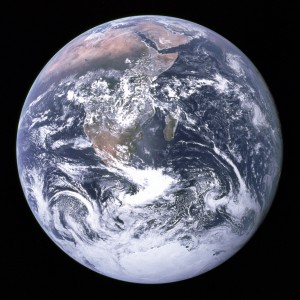20 February 2014
Predicting future societies could aid climate change research
Posted by Nanci Bompey

View of the Earth as seen by the Apollo 17 crew traveling toward the Moon. The climate change community is developing new socio-economic scenarios that could help climate scientists better predict the effects of climate change on the Earth.
Credit: NASA
What does a future society look like? Could it be one where people are far richer than they are today, but continue to burn fossil fuels in huge quantities? Might society decide to embrace renewable energy technologies, while its people become only slightly wealthier than they are now? What other futures might we expect?
Figuring out these different ways that society could develop can help climate scientists better predict the effects of climate change on the Earth and how best to respond to these changes, said speakers on a panel Sunday (Feb. 16) at a scientific meeting in Chicago. Scientists are now working to develop these different socio-economic scenarios, they said, in an effort that could help inform future climate-change research, climate assessments and policy changes.
The international climate-change research community is devising five Shared Socio-Economic Pathways, or SSPs, depicting different ways that society could develop in the future. These include changes in population and economic growth, technology, governance, education and other factors that could all influence how society responds to climate change.
For example, one scenario focuses on economic factors, depicting a society that is very rich, but still relies on fossil fuels. Another lays out a future where people are richer than they are today and society has switched to relying on renewable energy technology.
Using these SSPs in conjunction with different scenarios about how much the Earth will warm under different emissions scenarios will help form an integrated model of the future that takes into account both societal and climate changes, panelists said.
“These are intended to facilitate a whole bunch of research,” said Brian O’Neill, a scientist at the National Center for Atmospheric Research in Boulder, Colorado, who outlined the SSPs at the American Association for the Advancement of Science meeting in Chicago. “Having and using such a set of scenarios, we will also be better able to assess research after it is done.”
O’Neill said while there is some uncertainty associated with the scenarios because scientists don’t know what the future will hold, they could help researchers do a better job of predicting what the future may look like and what policy responses make the most sense. For example, scientists and policymakers could use the new scenarios to help better predict future agricultural production and prices.
The SSP developers are updating and expanding a set of scenarios developed 15 years ago and used in climate assessments, like some of the initial reports produced by the Intergovernmental Panel on Climate Change, O’Neill added. Not only do these scenarios need to be updated but the outlook for what the future might bring has changed and new scenarios are needed to accomplish different objectives than the previous ones did.
According to O’Neill, the developers hope the SSPs will become a common set of scenarios that can be used by many different researchers and provide better predictions for future climate assessments.
For more information:
http://www.cgd.ucar.edu/ccr/iam/
http://link.springer.com/article/10.1007%2Fs10584-013-0905-2
– Nanci Bompey, AGU Public Information Specialist – Writer










 GeoSpace is a blog on Earth and space science, managed by AGU’s Public Information staff. The blog features posts by AGU writers and guest contributors on all sorts of relevant science topics, but with a focus on new research and geo and space sciences-related stories that are currently in the news.
GeoSpace is a blog on Earth and space science, managed by AGU’s Public Information staff. The blog features posts by AGU writers and guest contributors on all sorts of relevant science topics, but with a focus on new research and geo and space sciences-related stories that are currently in the news.